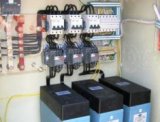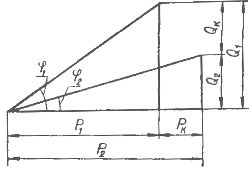Calculation and selection of capacitor banks for reactive power compensation
 The most common types of compensating devices that play the role of local generators of reactive power in enterprises are static capacitor banks and synchronous motors. Capacitor banks are installed in transformer substations of common factory workshops - on the low or high voltage side.
The most common types of compensating devices that play the role of local generators of reactive power in enterprises are static capacitor banks and synchronous motors. Capacitor banks are installed in transformer substations of common factory workshops - on the low or high voltage side.
The closer the compensating device is to the receivers of reactive energy, the more connections of the power system are unloaded from reactive currents. With centralized compensation, i.e. when installing capacitors at transformer substations, the capacity of the capacitor is used more fully.
The capacity of the capacitor banks can be determined from the diagram in fig. 1.

Rice. 1. Electrical diagram
Bk = P1 NS tgφ1 — P2 NS tgφ2,
where P1 and P2 — load before and after compensation, φ1 and φ2 — corresponding phase shift angles.
Reactive powergiven by the compensating plant,
Q = Q1 — Q2,
where Q1 and Q2 is the reactive power before and after compensation.
Active power consumed from the grid by the compensating device
Pk = P2 — P1.
The value of the required power of the capacitor bank can be determined approximately, without taking into account the losses in the capacitors, which are 0.003 — 0.0045 kW / kvar
Bk = P (tgφ1 — tgφ2)
An example of calculation and selection of capacitor banks for reactive power compensation
It is necessary to determine the rated power Qc of the capacitor bank required to increase the power factor to 0.95 in a plant with a three-shift uniform load curve. Average daily energy consumption Aa = 9200 kWh; Ap = 7400 kvarh. The capacitors are set at 380 V.
Average daily load
PSr = Aa / 24 = 9200/24 = 384 kW.
Capacitor bank power
Bk = P (tgφ1 — tgφ2) = 384 (0.8 — 0.32) = 185 kvar,
where tgφ1 = Ap / Aa = 7400/9200 = 0.8, tgφ2 = (1 — 0.952)/0.95 = 0.32
We choose three-phase capacitors of the type KM1-0.38-13, each with a nominal power of 13 kvar for a voltage of 380 V. The number of capacitors in the battery
n = Q / 13 = 185/13 = 14
Capacity of various condensing units for average daily load can be found in electrical manuals and manufacturers' catalogs.
